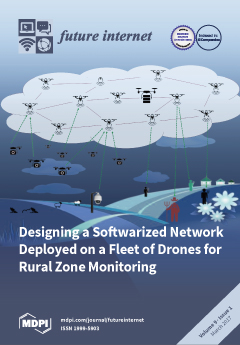Future Internet, Volume 9, Issue 1 (March 2017) – 9 articles
The backbone network is an SDN/NFV flying ad-hoc network (FANET), whose nodes are drones equipped with computing units, each hosting an NFV infrastructure (NFVI) point of presence (POP) to run the virtual service elements constituting the platform at the application level.
Video transmission is realized with video transmitter drones and fixed wireless IP cameras, all sending video transmissions of portions of the considered rural area. Receivers of the video monitoring service are people who access the platform through a smartphone, tablet or personal computer to monitor one or more portions of the rural area.
- Issues are regarded as officially published after their release is announced to the table of contents alert mailing list.
- You may sign up for e-mail alerts to receive table of contents of newly released issues.
- PDF is the official format for papers published in both, html and pdf forms. To view the papers in pdf format, click on the "PDF Full-text" link, and use the free Adobe Reader to open them.





